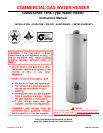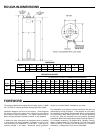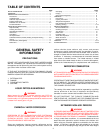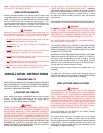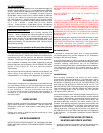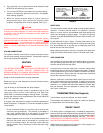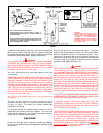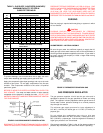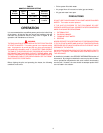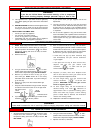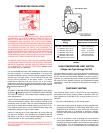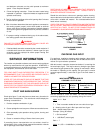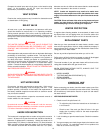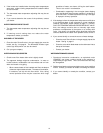14
4. If the heater was installed when incoming water temperatures
were warm, colder incoming temperatures will create the effect
of less hot water.
5. The thermostat water temperature adjusting dial may be set
too low.
6. If you cannot determine the cause of the problems, contact
your dealer.
WATER TEMPERATURE IS TOO HOT
1. The thermostat water temperature adjusting dial may be set
too high.
2. If lowering control setting does not reduce the water
temperature contact your dealer.
GAS SMELL AT THE HEATER
1. Close the main Shut-off valve in the gas supply pipe near the
heater, see fig. 4 on page 8. The thermostat includes a gas
control (top knob) which can also be closed.
2. Call your gas company.
WATER LEAKAGE IS SUSPECTED
1. Check to see if the heater drain valve is tightly closed.
2. The apparent leakage might be condensation. In warm or
humid locations, condensation can accumulate and run from
within the heater or its piping.
• When a water heater is first installed and filled, the bottom
of the tank might condense water. The water accumulation,
if excessive, can drip into the floor shield. Also, during
normal operation there may be occasions when large
quantities of water are drawn, chilling the tank bottom.
This too can result in condensation.
• Condensation, appearing in the vent pipe (water dripping
from draft diverter) during heater operation is evidence of
poor vent action. Possible causes are too long a vent pipe
or improper chimney operation.
3. If the leakage is from the temperature and pressure relief valve
or its discharge pipe, it may represent a normal condition.
However, see RELIEF VALVE section on page 12. DO NOT
PLUG THE TEMPERATURE AND PRESSURE RELIEF VALVE.
Also, the leakage could be due to unusually high water
pressures or temperatures in the system, or to a faulty relief
valve. Your dealer or a qualified service technician should be
called to determine the cause of the problem and to correct it.
4. If you cannot identify or correct the source of water leakage:
• Close the main Shut-off valve in the gas supply pipe at the
heater. See fig. 4, page 8.
• Close the valve which feeds water to the cold water inlet at
the top of the heater.
• Contact your dealer.
WATER HEATER MAKES SOUNDS
1. Occasional excessive condensation, as explained under
LEAKAGE, can cause a sizzling sound as the moisture is
vaporized by the gas flame. This is a normal sound and may
be disregarded.
2. Sediment and water scale accumulations may cause rumbling
noises. Contact your dealer for details of flushing the heater.
3. If you cannot identify or remedy the condition, contact your
dealer.



